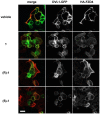Anticancer Activity of (S)-5-Chloro-3-((3,5-dimethylphenyl)sulfonyl)- N-(1-oxo-1-((pyridin-4-ylmethyl)amino)propan-2-yl)-1 H-indole-2-carboxamide (RS4690), a New Dishevelled 1 Inhibitor
- PMID: 35267666
- PMCID: PMC8909805
- DOI: 10.3390/cancers14051358
Anticancer Activity of (S)-5-Chloro-3-((3,5-dimethylphenyl)sulfonyl)- N-(1-oxo-1-((pyridin-4-ylmethyl)amino)propan-2-yl)-1 H-indole-2-carboxamide (RS4690), a New Dishevelled 1 Inhibitor
Abstract
Wingless/integrase-11 (WNT)/β-catenin pathway is a crucial upstream regulator of a huge array of cellular functions. Its dysregulation is correlated to neoplastic cellular transition and cancer proliferation. Members of the Dishevelled (DVL) family of proteins play an important role in the transduction of WNT signaling by contacting its cognate receptor, Frizzled, via a shared PDZ domain. Thus, negative modulators of DVL1 are able to impair the binding to Frizzled receptors, turning off the aberrant activation of the WNT pathway and leading to anti-cancer activity. Through structure-based virtual screening studies, we identified racemic compound RS4690 (1), which showed a promising selective DVL1 binding inhibition with an EC50 of 0.74 ± 0.08 μM. Molecular dynamic simulations suggested a different binding mode for the enantiomers. In the in vitro assays, enantiomer (S)-1 showed better inhibition of DVL1 with an EC50 of 0.49 ± 0.11 μM compared to the (R)-enantiomer. Compound (S)-1 inhibited the growth of HCT116 cells expressing wild-type APC with an EC50 of 7.1 ± 0.6 μM and caused a high level of ROS production. These results highlight (S)-1 as a lead compound for the development of new therapeutic agents against WNT-dependent colon cancer.
Keywords: DVL1; PDZ domain; WNT pathway; cancer; virtual screening.
Conflict of interest statement
The authors declare no conflict of interest.
Figures







References
LinkOut - more resources
Full Text Sources

